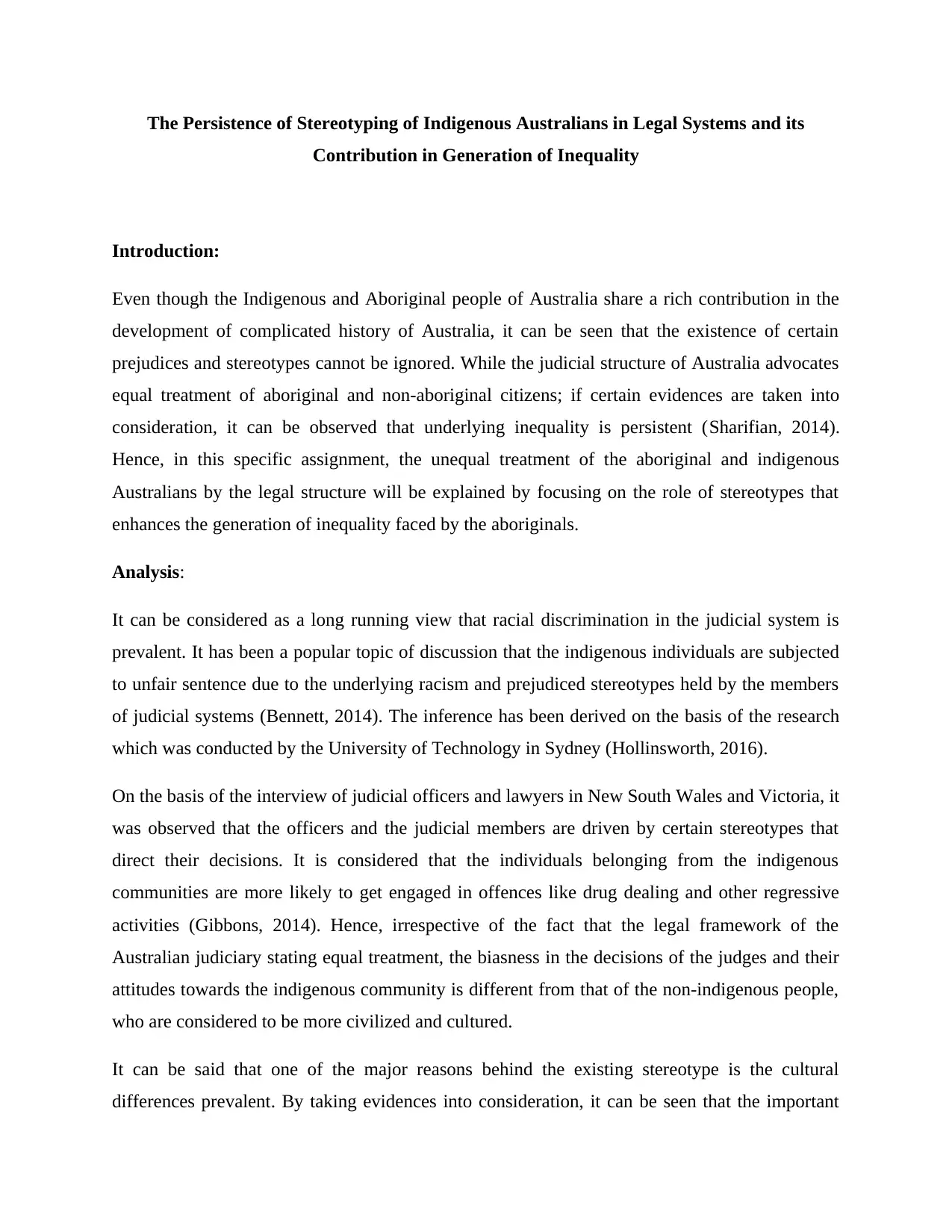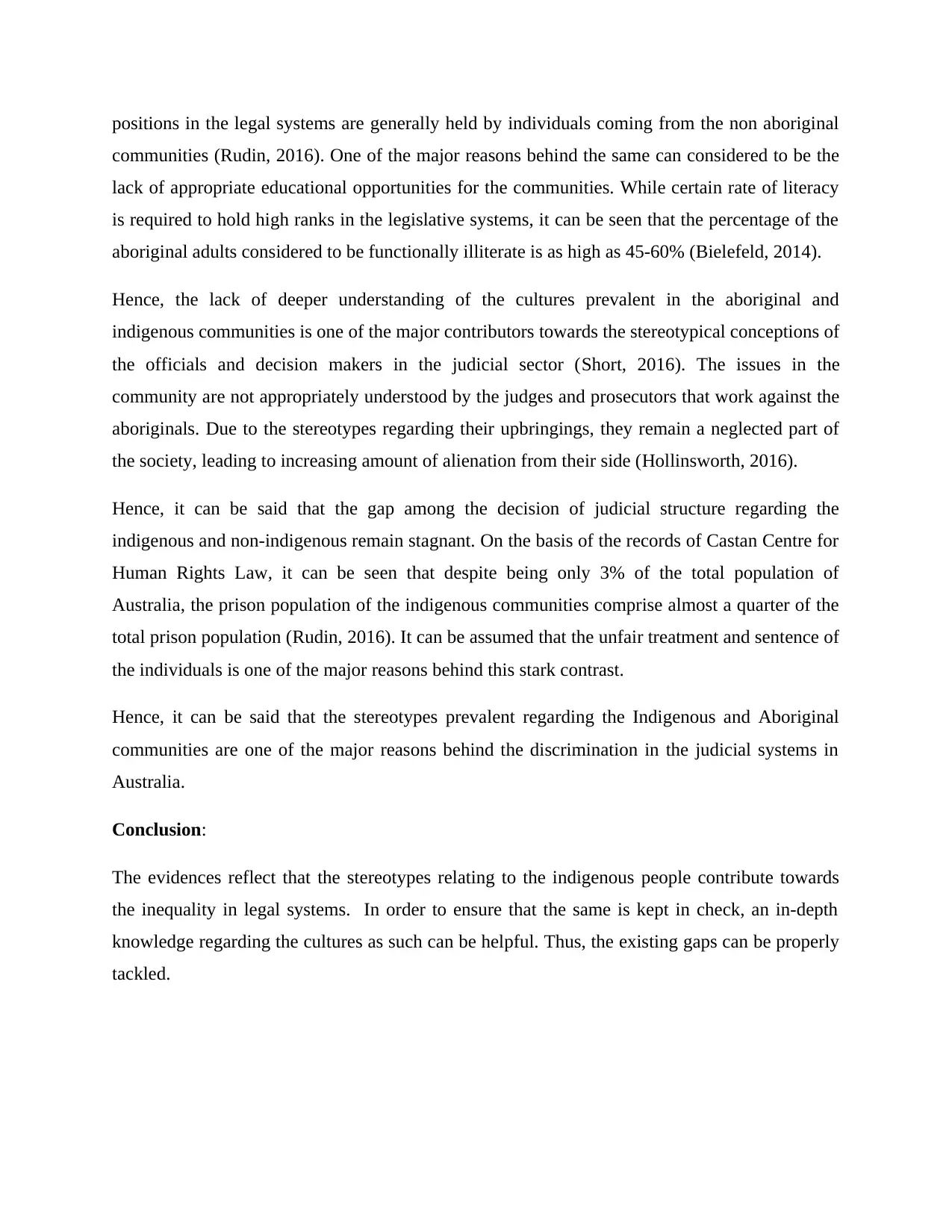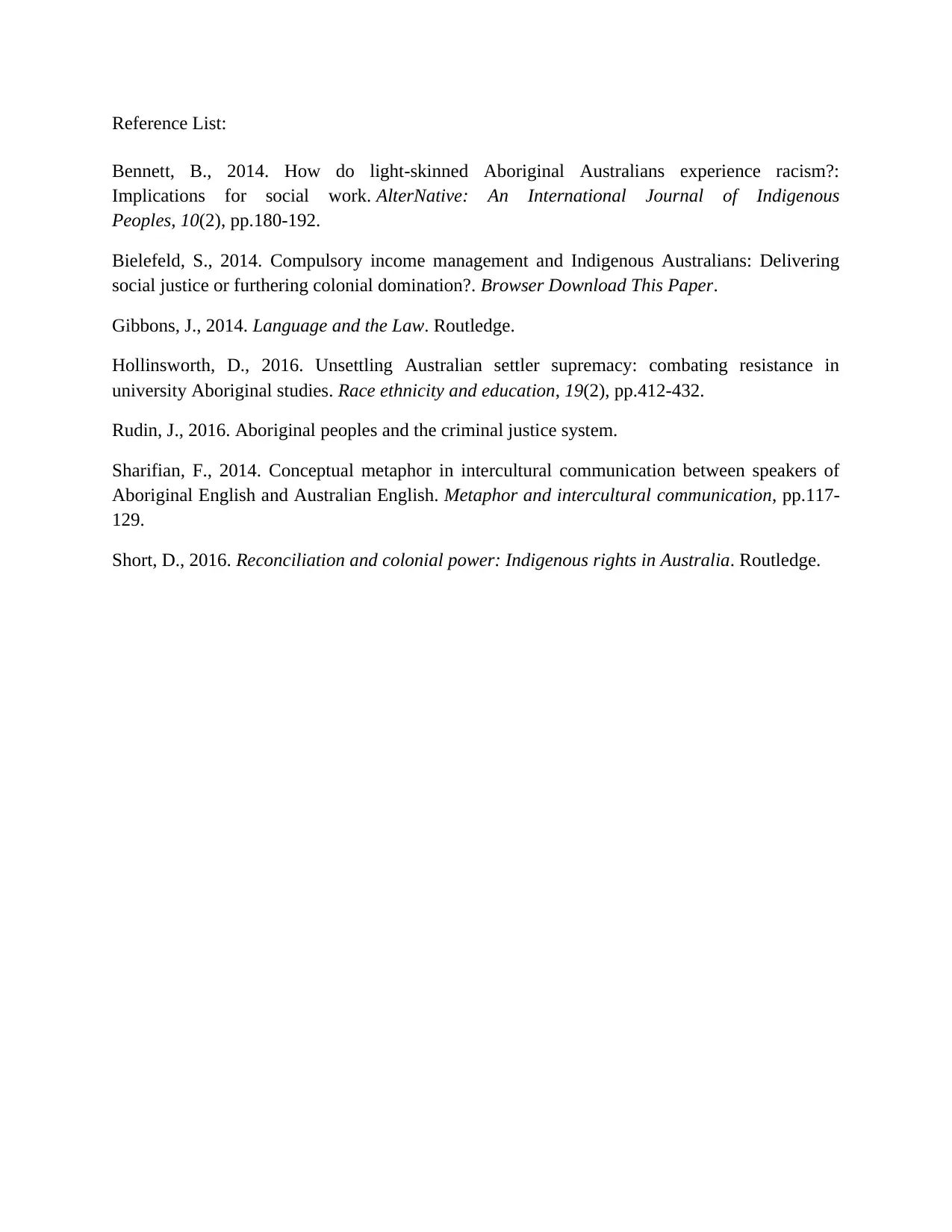Persistence of Stereotypes in Legal Systems and Indigenous Inequality
VerifiedAdded on 2020/03/04
|3
|916
|495
Essay
AI Summary
This essay explores the persistent issue of stereotyping against Indigenous Australians within the Australian legal system and its contribution to the generation of inequality. The introduction highlights the historical context of Indigenous Australians and the existence of prejudices and stereotypes, despite the legal system's advocacy for equal treatment. The analysis delves into the prevalence of racial discrimination, citing research that suggests unfair sentencing due to stereotypes held by judicial members. The essay examines cultural differences, lack of educational opportunities, and the resulting stereotypical conceptions of officials, leading to alienation and a stark contrast in the treatment of Indigenous and non-Indigenous individuals within the legal system. The conclusion emphasizes the need for in-depth knowledge regarding Indigenous cultures to address existing gaps and ensure fairness.

The Persistence of Stereotyping of Indigenous Australians in Legal Systems and its
Contribution in Generation of Inequality
Introduction:
Even though the Indigenous and Aboriginal people of Australia share a rich contribution in the
development of complicated history of Australia, it can be seen that the existence of certain
prejudices and stereotypes cannot be ignored. While the judicial structure of Australia advocates
equal treatment of aboriginal and non-aboriginal citizens; if certain evidences are taken into
consideration, it can be observed that underlying inequality is persistent (Sharifian, 2014).
Hence, in this specific assignment, the unequal treatment of the aboriginal and indigenous
Australians by the legal structure will be explained by focusing on the role of stereotypes that
enhances the generation of inequality faced by the aboriginals.
Analysis:
It can be considered as a long running view that racial discrimination in the judicial system is
prevalent. It has been a popular topic of discussion that the indigenous individuals are subjected
to unfair sentence due to the underlying racism and prejudiced stereotypes held by the members
of judicial systems (Bennett, 2014). The inference has been derived on the basis of the research
which was conducted by the University of Technology in Sydney (Hollinsworth, 2016).
On the basis of the interview of judicial officers and lawyers in New South Wales and Victoria, it
was observed that the officers and the judicial members are driven by certain stereotypes that
direct their decisions. It is considered that the individuals belonging from the indigenous
communities are more likely to get engaged in offences like drug dealing and other regressive
activities (Gibbons, 2014). Hence, irrespective of the fact that the legal framework of the
Australian judiciary stating equal treatment, the biasness in the decisions of the judges and their
attitudes towards the indigenous community is different from that of the non-indigenous people,
who are considered to be more civilized and cultured.
It can be said that one of the major reasons behind the existing stereotype is the cultural
differences prevalent. By taking evidences into consideration, it can be seen that the important
Contribution in Generation of Inequality
Introduction:
Even though the Indigenous and Aboriginal people of Australia share a rich contribution in the
development of complicated history of Australia, it can be seen that the existence of certain
prejudices and stereotypes cannot be ignored. While the judicial structure of Australia advocates
equal treatment of aboriginal and non-aboriginal citizens; if certain evidences are taken into
consideration, it can be observed that underlying inequality is persistent (Sharifian, 2014).
Hence, in this specific assignment, the unequal treatment of the aboriginal and indigenous
Australians by the legal structure will be explained by focusing on the role of stereotypes that
enhances the generation of inequality faced by the aboriginals.
Analysis:
It can be considered as a long running view that racial discrimination in the judicial system is
prevalent. It has been a popular topic of discussion that the indigenous individuals are subjected
to unfair sentence due to the underlying racism and prejudiced stereotypes held by the members
of judicial systems (Bennett, 2014). The inference has been derived on the basis of the research
which was conducted by the University of Technology in Sydney (Hollinsworth, 2016).
On the basis of the interview of judicial officers and lawyers in New South Wales and Victoria, it
was observed that the officers and the judicial members are driven by certain stereotypes that
direct their decisions. It is considered that the individuals belonging from the indigenous
communities are more likely to get engaged in offences like drug dealing and other regressive
activities (Gibbons, 2014). Hence, irrespective of the fact that the legal framework of the
Australian judiciary stating equal treatment, the biasness in the decisions of the judges and their
attitudes towards the indigenous community is different from that of the non-indigenous people,
who are considered to be more civilized and cultured.
It can be said that one of the major reasons behind the existing stereotype is the cultural
differences prevalent. By taking evidences into consideration, it can be seen that the important
Paraphrase This Document
Need a fresh take? Get an instant paraphrase of this document with our AI Paraphraser

positions in the legal systems are generally held by individuals coming from the non aboriginal
communities (Rudin, 2016). One of the major reasons behind the same can considered to be the
lack of appropriate educational opportunities for the communities. While certain rate of literacy
is required to hold high ranks in the legislative systems, it can be seen that the percentage of the
aboriginal adults considered to be functionally illiterate is as high as 45-60% (Bielefeld, 2014).
Hence, the lack of deeper understanding of the cultures prevalent in the aboriginal and
indigenous communities is one of the major contributors towards the stereotypical conceptions of
the officials and decision makers in the judicial sector (Short, 2016). The issues in the
community are not appropriately understood by the judges and prosecutors that work against the
aboriginals. Due to the stereotypes regarding their upbringings, they remain a neglected part of
the society, leading to increasing amount of alienation from their side (Hollinsworth, 2016).
Hence, it can be said that the gap among the decision of judicial structure regarding the
indigenous and non-indigenous remain stagnant. On the basis of the records of Castan Centre for
Human Rights Law, it can be seen that despite being only 3% of the total population of
Australia, the prison population of the indigenous communities comprise almost a quarter of the
total prison population (Rudin, 2016). It can be assumed that the unfair treatment and sentence of
the individuals is one of the major reasons behind this stark contrast.
Hence, it can be said that the stereotypes prevalent regarding the Indigenous and Aboriginal
communities are one of the major reasons behind the discrimination in the judicial systems in
Australia.
Conclusion:
The evidences reflect that the stereotypes relating to the indigenous people contribute towards
the inequality in legal systems. In order to ensure that the same is kept in check, an in-depth
knowledge regarding the cultures as such can be helpful. Thus, the existing gaps can be properly
tackled.
communities (Rudin, 2016). One of the major reasons behind the same can considered to be the
lack of appropriate educational opportunities for the communities. While certain rate of literacy
is required to hold high ranks in the legislative systems, it can be seen that the percentage of the
aboriginal adults considered to be functionally illiterate is as high as 45-60% (Bielefeld, 2014).
Hence, the lack of deeper understanding of the cultures prevalent in the aboriginal and
indigenous communities is one of the major contributors towards the stereotypical conceptions of
the officials and decision makers in the judicial sector (Short, 2016). The issues in the
community are not appropriately understood by the judges and prosecutors that work against the
aboriginals. Due to the stereotypes regarding their upbringings, they remain a neglected part of
the society, leading to increasing amount of alienation from their side (Hollinsworth, 2016).
Hence, it can be said that the gap among the decision of judicial structure regarding the
indigenous and non-indigenous remain stagnant. On the basis of the records of Castan Centre for
Human Rights Law, it can be seen that despite being only 3% of the total population of
Australia, the prison population of the indigenous communities comprise almost a quarter of the
total prison population (Rudin, 2016). It can be assumed that the unfair treatment and sentence of
the individuals is one of the major reasons behind this stark contrast.
Hence, it can be said that the stereotypes prevalent regarding the Indigenous and Aboriginal
communities are one of the major reasons behind the discrimination in the judicial systems in
Australia.
Conclusion:
The evidences reflect that the stereotypes relating to the indigenous people contribute towards
the inequality in legal systems. In order to ensure that the same is kept in check, an in-depth
knowledge regarding the cultures as such can be helpful. Thus, the existing gaps can be properly
tackled.

Reference List:
Bennett, B., 2014. How do light-skinned Aboriginal Australians experience racism?:
Implications for social work. AlterNative: An International Journal of Indigenous
Peoples, 10(2), pp.180-192.
Bielefeld, S., 2014. Compulsory income management and Indigenous Australians: Delivering
social justice or furthering colonial domination?. Browser Download This Paper.
Gibbons, J., 2014. Language and the Law. Routledge.
Hollinsworth, D., 2016. Unsettling Australian settler supremacy: combating resistance in
university Aboriginal studies. Race ethnicity and education, 19(2), pp.412-432.
Rudin, J., 2016. Aboriginal peoples and the criminal justice system.
Sharifian, F., 2014. Conceptual metaphor in intercultural communication between speakers of
Aboriginal English and Australian English. Metaphor and intercultural communication, pp.117-
129.
Short, D., 2016. Reconciliation and colonial power: Indigenous rights in Australia. Routledge.
Bennett, B., 2014. How do light-skinned Aboriginal Australians experience racism?:
Implications for social work. AlterNative: An International Journal of Indigenous
Peoples, 10(2), pp.180-192.
Bielefeld, S., 2014. Compulsory income management and Indigenous Australians: Delivering
social justice or furthering colonial domination?. Browser Download This Paper.
Gibbons, J., 2014. Language and the Law. Routledge.
Hollinsworth, D., 2016. Unsettling Australian settler supremacy: combating resistance in
university Aboriginal studies. Race ethnicity and education, 19(2), pp.412-432.
Rudin, J., 2016. Aboriginal peoples and the criminal justice system.
Sharifian, F., 2014. Conceptual metaphor in intercultural communication between speakers of
Aboriginal English and Australian English. Metaphor and intercultural communication, pp.117-
129.
Short, D., 2016. Reconciliation and colonial power: Indigenous rights in Australia. Routledge.
⊘ This is a preview!⊘
Do you want full access?
Subscribe today to unlock all pages.

Trusted by 1+ million students worldwide
1 out of 3
Related Documents
Your All-in-One AI-Powered Toolkit for Academic Success.
+13062052269
info@desklib.com
Available 24*7 on WhatsApp / Email
![[object Object]](/_next/static/media/star-bottom.7253800d.svg)
Unlock your academic potential
Copyright © 2020–2025 A2Z Services. All Rights Reserved. Developed and managed by ZUCOL.





